![]()
![]()
![]()
Use LEFT and RIGHT arrow keys to navigate between flashcards;
Use UP and DOWN arrow keys to flip the card;
H to show hint;
A reads text to speech;
70 Cards in this Set
- Front
- Back
|
logarithmic graph |
• vertical asyp at x=0 • (1,0) (#,1) the # represents the base the log given is |
|
|
exponential graph |
•horizontal asymp at y=0 •(0,1) (1,#) |
|
|
what do these cause?: • -x • -function (cos, log, #) |
1. shift across y (make x int neg) 2. shift across x (make y int neg) |
|
|
log = ? |
log10 |
|
|
ln(e) = ? |
1 |
|
|
loga(1) = ? |
0 |
|
|
loga(a) = ? |
1 |
|
|
what should u remember when changing from a log to an exponential equation or vice versa? |
y = loga(x) & x = a^y or bae for log to e and bao for e to log |
|
|
what are the properties of logs? |
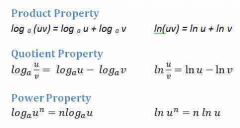
|
|
|
how do you solve absolute value equations? |
1. get rid of the absolute value brackets 2. get the absolute value on its own (if it isn't already) 3. solve like a linear equ 4. if there's more than one, you basically have to repeat steps 1-3 for the second one. make sure once u isolate the absolute value that what comes after the = sign u make solve one for pos and one for neg |
|
|
how do you check for extraneous solutions for absolute value problems? |
plug in your answer into the original equation |
|
|
how can you tell if a function is even, odd, or neither by looking at its graph? |
even- symmetrical about the y axis odd- symmetrical about both x and y axis neither- ..neither lol remember to check the coefficient to see if it's neg!!! |
|
|
degrees to radians |
multiply by the constant pi/180 |
|
|
radians to degrees |
multiply by the constant 180/pi |
|
|
how do you find a coterminal angle? how do you know it's within range? |
subtract by 2pi/1 (make sure to get common den!!) it's in range if it's less than 16pi/8 |
|
|
define period. how do you find it? |
what the units are being counted by. the period is automatically 2pi. if x is being multiplied by something then u find it by doing 2pi/1 • reciprocal of x |
|
|
define amplitude. how do you find it? |
distance from the middle of the function to the max/min height whatever the trig function is being multiplied by is the amp |
|
|
when graphing trig functions (cos sin etc) what happens if x is being multiplied and added? |
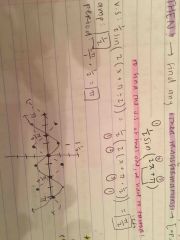
you have to factor it to find the vertical shift. do this by factoring out what x is being multiplied by. then we multiply whatever they gave u for pi by the recip of x) |
|
|
describe the parent function of sin |

|
|
|
describe the parent function of cos |
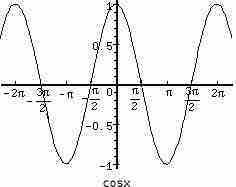
|
|
|
when do we use inverse functions? |
when we need to know an angle value use them to isolate a trig function to get theta on its own |
|
|
when doing unit circle questions for inverse trig, what should you remember? |
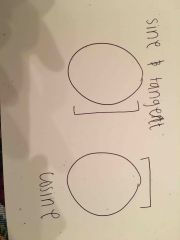
u have to look at these parts of the unit circle |
|
|
what are all the fundamental identities? |

Back (Definition) |
|
|
what are the main steps for solving problems using the half and double angle formula? |
1. get equal to 0 2. use formula (note: +/- goes away as does the square and the sqrt) 3. simplify and factor to get everything being multiplied. (bc then you can solve since it's set equal to 0) 4. find answers on unit circle |
|
|
how do you solve for an angle if it's a right triangle? if it's not? |
right: plug in trig function(angle) = SOH CAH OR TOA then simplify by getting x alone. not right: use law of sines or law of cosines |
|
|
when do you use law of sines? law of cosines? |
sine- given angles cos- 1 or less angle or mainly sides given u may not need to do inverse for these. the main goal is getting x alone. |
|
|
how do you graph polynomial functions? |
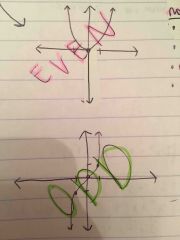
1. figure out if it's even or odd so u can draw the p function 2. figure out any transformations and apply. remember: fractions make u fat. if the fraction is neg, it actually gets skinner tho |
|
|
how do you find all the zeroes of a polynomial function? |
1. list all possible roots (of the first and last #) 2. use synthetic division to which root to use. u know it's the one when the remainder is 0 3. factor |
|
|
what should u remember when doing synthetic division |
above line multiply below line add also go down a degree when writing ur new answer |
|
|
what is tan - -1 ? |
it's not -tan. it's tan + 1 you cannot add/sub a number with a trig function |
|
|
what should u ask when adding or subtracting fractions? |
does this thing need common den |
|
|
when multiplying fractions what should u remember? |
multiply the den too |
|
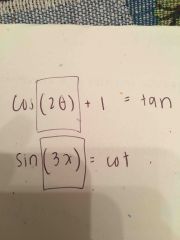
what should u remember when dealing w problems like this? |
for the things that are boxed, do these last. solve the equ and once it's set equal to 0 u then divide or multiply the reciprocal to get rid of these. |
|
|
what can u break up in the numerator? denominator? |
num - addition den - multiplication |
|
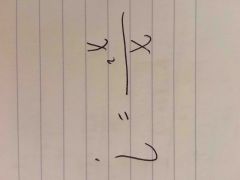
|
1/x |
|
|
for rational equations, how can you determine extraneous solutions? |
set the common denominator equal to 0. those cannot be your solutions. |
|
|
case 1 for rational function graphs |
den is bigger than num horizontal asymptote at y=0 remember the y part!!! |
|
|
case 2 for rational function graphs |
den and num are the same divide leading coefficients to find horizontal asymptote |
|
|
case 3 for rational function graphs |
num is bigger than den use synthetic division to figure out the slant asymptote. (make sure to change the sign!) |
|
|
what is the main goal in solving rational equations? |
get rid of the denominators and equal to 0. get rid of den by multiplying everything by a common den |
|
|
how can you find the vertical asymptotes or holes of a rational function? |
vertical - set den equal to 0. change sign holes - if anything cancels out, you'll have a hole there.
|
|
|
what is the equation of a circle? |
(x - h)^2 + (y - k)^2 = r^2 |
|
|
when dealing with square roots what should u remember? |
put the plus and minus sign!! |
|
|
unit circle |

Back (Definition) |
|
|
what's the quadratic formula |

Back (Definition) |
|
|
what happens if u get a square root that doesn't simplify? |
simplify it further by finding 2 numbers that multiply to give u that and then square root anything and put that outside and leave the one that didn't simplify inside |
|
|
when solving log equations what should u remember? |
if they have the same base u can get rid of the log |
|
|
when dealing with exponents what should u remember? |
you can only sub, add, etc if they have the same base!! |
|
|
what are the cofunction identities? |
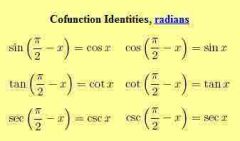
Back (Definition) |
|
|
when should you get something equal to zero? |
when your dealing with an equation that you would need to factor. (if there's more than one trig function) |
|
|
what is (x + #)^2? |
(x + #)(x + #) NOT X^2 + #^2 |
|
|
how do you find interval of increase/decrease? |
look at x values. remember that the function might be growing wider so it might be infinity |
|
|
what are the square root properties? |

Back (Definition) |
|
|
what's something u should remember about logs? |
u can't have negative ones |
|
|
what should u remember if a variable is on the bottom? (ie 150/b) |
multiply by the variable to get t out of the den |
|
|
how do you find the center and radius of a circle? then how do you graph it? |
center: (x - h)^2 (y - k)^2 just change the sign radius: the # after the = sign. find what squared gives u that #. to graph, plot ur center then ur radius tells u how many points to go out and up from there. |
|
|
how do you determine the equation of a circle? |
1. group x's and y's together 2. divide the x term by 2 the. square it. add that # to ur equ 3. subtract the # u got from step 2 from the parenthesis (to cancel it out) 4. factor 5. combine like terms and make sure it's in the equation of a circle from (add/sub the random # to the other side of the = to get the radius) |
|
|
what is the goal when solving logs? |
get x by itself. u can do this by changing to exponential, using properties, solving like a linear equ. |
|
|
what is the goal when solving logs? |
get x by itself. u can do this by changing to exponential, using properties, solving like a linear equ. |
|
|
how do you find plots for a rational graph? |
set x equal to 0 and y equal to 0. |
|
|
how do you find plots for a rational graph? |
set x equal to 0 and y equal to 0. |
|
|
when ur solving an equation or using the difference formulas what should you do if you get a value of a trig function that isn't on the unit circle? |
use inverse trig to get theta alone |
|
|
if ur dealing with a radian that's not on the unit circle what should u do? |
the sum/diff formula |
|
|
when looking for something on the unit circle, what should u make sure to do? |
make sure the trig function isn't neg. if it is, just divide by -1 |
|
|
at the end of the test what do u need to make sure u do? |
CHECK ALL UR ANSWERS BY PLUGGING THEM BACK INTO UR ORIG EQU |
|
|
if u see something cubed, what do u need to do? |
synthetic division |
|
|
what is the domain for any polynomial? |
neg infinity to infinity or all real numbers |
|
|
what is the domain for any polynomial? |
neg infinity to infinity or all real numbers |
|
|
if ur stuck on an equ u should |
start over and start on the other side |
|
|
if u get a fraction as an answer, what should u ask? |
can i simplify this further? |

